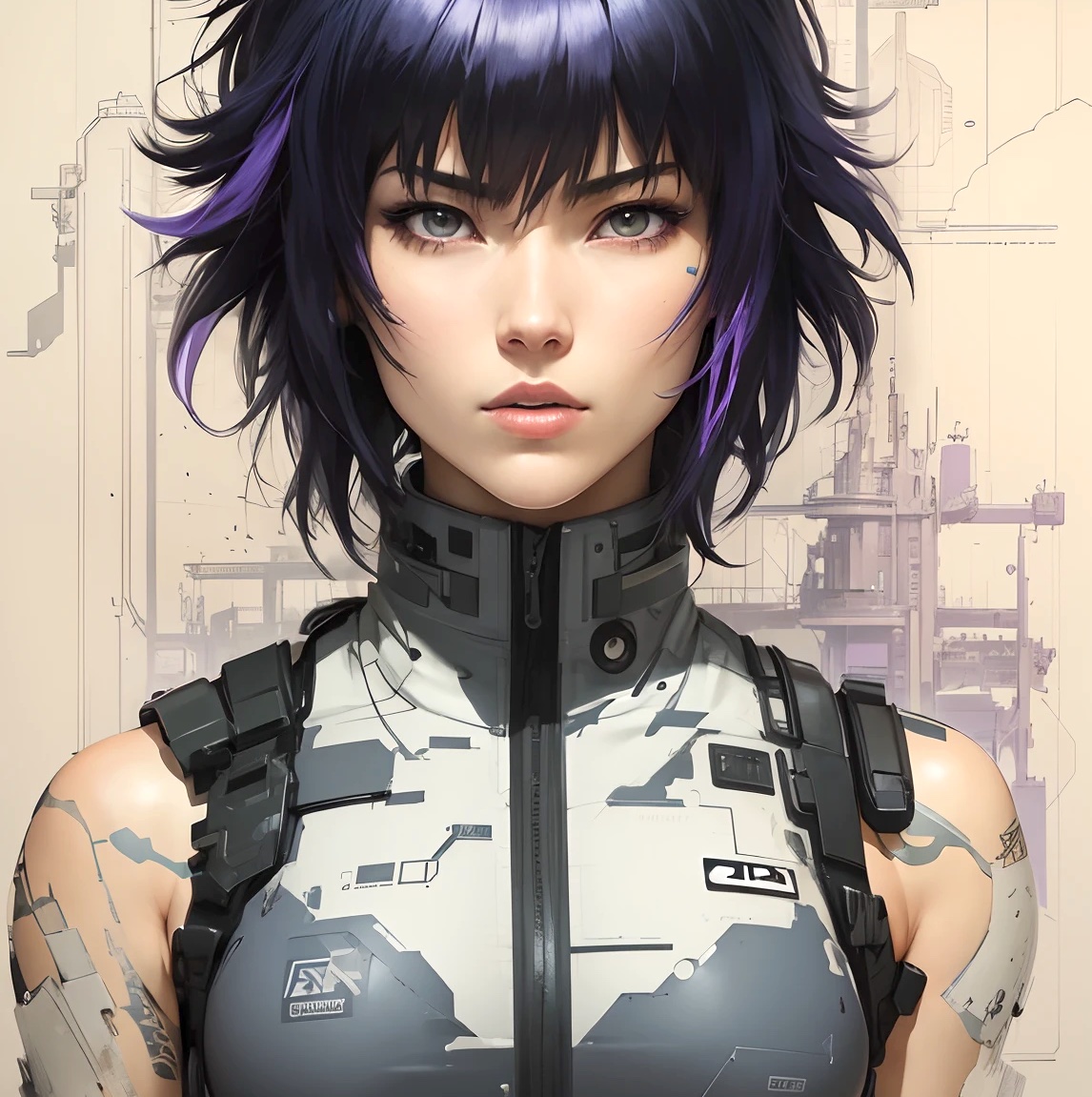When Ghost in the Shell arrived on Western screens in 1995, it didn’t so much introduce Japanese cyberpunk to the world, it translated a question already haunting the wires: What, exactly, is the self in an age of code? Mamoru Oshii’s animated film adaptation of Masamune Shirow’s manga was quiet, meditative, and full of pauses. Its protagonist, Major Motoko Kusanagi, could kill a man with one hand and then spend ten minutes staring into traffic. This wasn’t a bug in the narrative. It was the point. In Ghost in the Shell, identity is not an action, it’s a haunting.
Western audiences accustomed to action-forward cyberpunk like Blade Runner (which itself owes more than a little to Japanese visual philosophy) were confronted with a story that gave equal weight to internal dislocation and external violence. Motoko isn’t just a cyborg with questions, she’s a philosophical problem in motion. Her body is entirely synthetic, her memories possibly planted, and yet she is undeniably something. The manga played more with sexuality, humor, and team dynamics. Oshii’s film distilled this into atmosphere and ontological dread.
Then came the 2017 live-action remake, a Hollywood version starring Scarlett Johansson. The shell was there, slick visuals, cybernetic enhancements, iconic water scenes, but the ghost seemed a little… muted. It wasn’t just about casting controversies or cultural borrowing. It was a tonal shift. The film replaced much of the original’s ambiguity with exposition. Motoko becomes Mira Killian, a brain-in-a-jar experiment by an evil corporation. Her question isn’t “What is the soul in a synthetic body?” but “Who did this to me?” Identity becomes a plot twist, not a philosophical dilemma.
To be fair, the live-action film didn’t entirely ignore the source material’s questions. It gestured toward memory manipulation, corporate control, and posthuman identity. But where the anime allowed silence to do the heavy lifting, those cityscapes, those slow dissolves, the remake fills the space with dialogue. It tells instead of suggests. And that’s the key difference. The original Ghost in the Shell doesn’t want to answer questions. It wants to leave you in them.
In Japanese philosophy, particularly Zen Buddhism and Shinto, the self is not fixed. It is a flowing thing, shaped by relationships, the natural world, even objects. This is why Ghost in the Shell resonates so deeply, it reflects mushin (no-mind), kokoro (heart-mind), and the idea that a soul might exist in the in-between. The “ghost” is not a soul in the Christian sense. It’s closer to ki, to presence, to awareness that can move through wires and still feel pain. Oshii’s version hints that evolution might not be biological but existential.
The manga, the anime, and the film all explore what it means to be human in a world where the human is increasingly optional. But only the original anime leans into that with both reverence and restraint. The Hollywood version tells us who the Major was. The anime asks who she might become.
There’s a reason Ghost in the Shell influenced The Matrix. The Wachowskis understood what Western studios often miss: the depth isn’t in the tech. It’s in the stillness. In watching Motoko drift underwater, we feel the weight of existence as something not just worn, but questioned. The anime trusts the viewer to hold paradox. The Hollywood version, like many adaptations, fears ambiguity. And so it replaces introspection with narrative symmetry.
That’s not to say the live-action version is without value. It introduces a new audience to a philosophical lineage many might have missed. And perhaps it needed to be imperfect. Ghost in the Shell has always been about glitches, ghosts in the machine, memories in the margins. Even its adaptations become part of its own self-questioning loop.
Author’s Note
If you suddenly suspect your coffee machine is self-aware, be kind. It probably just watched the anime.
愛と死と浪人のゴースト ― このSF妄想がなぜか和風に感じる理由
『Love, Death & Robots』は日本製じゃないし、アニメでもない。なのに観ていると、どこかで見たような風景に迷い込んでしまう。侍物の語り口、クロームに包まれた道徳、そして爆発するモンスターや喋る猫が登場する割に、なぜか詩的な静けさが漂っている。このNetflixアンソロジーは西洋生まれだが、物語の魂はたびたび霧に包まれた日本的なるものへと彷徨っていく。桜や刀のような記号的な演出ではなく、もっと内面的な構造だ。孤独、誇り、儚さ、そして手の届かない美しさへの切なさ。
たとえば、繰り返し登場する“孤高の戦士”。ある話では、女性兵士が外骨格スーツをまとい、終わりなきエイリアンの波に一人で立ち向かう。別の話では、サイボーグの傭兵が、自分の中に残る「人間らしさ」と対峙する。これは単なるアクションの型ではない。まるで浪人だ。主君を持たぬ侍が、崩れかけた世の中を黙々と歩くように、西洋の“一匹狼”とは違う、静かな責任感と哀しみを背負った存在だ。『Love, Death & Robots』の戦いには、しばしば“勝ち負け”以上の意味がある。それは、崩壊に抗う意志そのものなのだ。
ここに、武士道がそっと顔を出す。名誉、忠義、自己犠牲。短編形式の中で登場するキャラクターたちは、人間であれロボットであれ、何かしらの「内なる掟」に従って生きている。文明が崩壊しても、任務を全うする兵士。古い命令を守り続ける機械。復讐は冷たく、愛は報われず、それでも誰も動機を語らない。ただ、黙って行動する。そこにあるのは、説明不要の倫理。まるで黒澤映画のように、沈黙がすべてを物語る。
そして、もう一つの核心──もののあわれの感触。『Love, Death & Robots』が「和風」に感じられる最大の理由は、美しさと儚さが隣り合っているからだ。星空を見上げるロボット、-瞬の記憶に涙する兵士、破壊の中で佇むひとりの生存者-そういう「余韻」が、静かに心に残る。これは『エヴァンゲリオン』の夢のようなラストや『AKIRA』の雪のように、日本のアニメが得意としてきた感性でもある。暴力と美は相反するものではなく、共存してこそ人間的なのだ。
また、物語の奥にはひそやかに神道的な視点も潜んでいる。神道では、物にも場所にも「魂」が宿るとされる。だから日本の物語では、ロボットはただの機械ではなく、記憶と感情の器でもある。『Love, Death & Robots』でも、機械はしばしば人間を映す鏡として描かれる。完璧ではないが、共感する可能性はある。その境界は、VFXではなく、沈黙と道徳的なあいまいさの中にぼんやりと浮かび上がる。
はっきり言っておこう。『Love, Death & Robots』はアニメではない。国際的なスタッフによる、西洋的な美学で作られた作品だ。でも、その構成 – 短く、独立し、思想に満ちた各エピソード――は、まるでアニメ化された禅問答のようにも感じられる。アイデンティティ、死、意識。それぞれの物語は違っても、どれも同じ問いを投げかけている。「世界が無関心になった時、人間らしさとは何か?」
それはつまり、「愛」と「死」と「ロボット」の話ではない。すべてが壊れた後に、何が残るかの物語なのだ。そしてそれこそが、このシリーズを“最も日本的な非日本作品”にしている理由かもしれない。
著者のひとこと:
もし電子レンジが突然詩を書き始め、自己犠牲について考え込んでいたら、そっとコンセントを抜いてあげてください。今、ひとりの時間が必要なようです。ちなみに執筆中、ロボットは一体も傷つけていません。ただ一体、俳句を学ぶために長期休暇を申請しました。


Leave a Reply